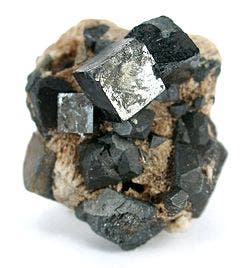Xenon is a noble gas, the second heaviest of the chemically inert noble gases. The only problem with is that… it’s gone missing! Xenon is almost entirely missing from our atmosphere, somethign which researchers were unable to answer – until now, that is. German researchers believe they managed to find out where the gas is hiding.
In the air or in the ground?

“Scientists always said the xenon is not really missing. It’s not in the atmosphere, but it’s hiding somewhere,” says professor Hans Keppler, a geophysicist at the University of Bayreuth in Germany. He and his colleague Svyatoslav Shcheka are the latest geoscientists to tackle the case, in a report published today in Nature.
As you could expect from geophysicists, they searched for the answer in minerals. A magnesium silicate, called perovskite, is a major component of the Earth’s lower mantle. For some reason, they had a hunch the xenon might be hiding in this perkovite, so they went searching.
“I was quite sure that it must be possible to stuff noble gases into perovskite,” says Keppler. “I suspected xenon may be in there.”
Researchers tried replicating the conditions in the lower mantle, and so they dissolved xenon and argon in perovskite at temperatures exceeding 1,600 ºC and pressures about 250 times those at sea level. Under these conditions, the mineral dramatically absorbed argon, but had little room left for xenon. This result seemed pretty disappointing, but in fact, it gave geophysicists a rather strange idea: What if the xenon isn’t hiding at all?
Elementary, my dear Watson
Some 4 billion years ago, the Earth was truly a hellish place. It was still a molten mass, lacking an atmosphere and constantly bombarded by meteorites. Keppler and Shcheka suggest that argon and other noble gases hid in the perovskite, which was on the surface then, and xenon, unable to dissolve, simply went into outer space.
“This is completely different from what everybody else is saying. They are saying the xenon is here but it’s hiding somewhere. We are saying it is not here because very early in Earth’s history it had no place to hide,” says Keppler.
When the Earth started cooling and the atmosphere started forming, a big part of the noble gases were released in the atmosphere, but by that time, xenon was already gone. As a significant, but not fully conclusive evidence, researchers also point out that the relative ratios of three noble gases — xenon, krypton and argon — pretty much correspond to their relative sollubilities in erovskite.
But not all agree with this creative theory:
“I don’t think this discovery accounts for the missing xenon.”, says Chrystele Sanloup, a geoscientist at Pierre and Marie Curie University in Paris. She notes that the theory does not totally explain all of the excess heavy xenon in the atmosphere, nor for additional xenon made from the radioactive decay of uranium and plutonium in rocks.
Besides, every explanation that works on Earth should also work on Mars too, right? Keppler and Shcheka suggest that here, too, the ancient xenon escaped into space: the planet’s puny gravitational field prevented it from holding onto the gas. As a result, all the xenon found on the red planet is what little could dissolve into the early perovskite. But some don’t believe Mars had all that perovskite to begin with. That being said, we’re going to have to solve this mystery on Mars too, if the theory works.
Results were published in Nature: Shcheka, S. S. & Keppler, H. Nature http://dx.doi.org/10.1038/nature11506 (2012).






